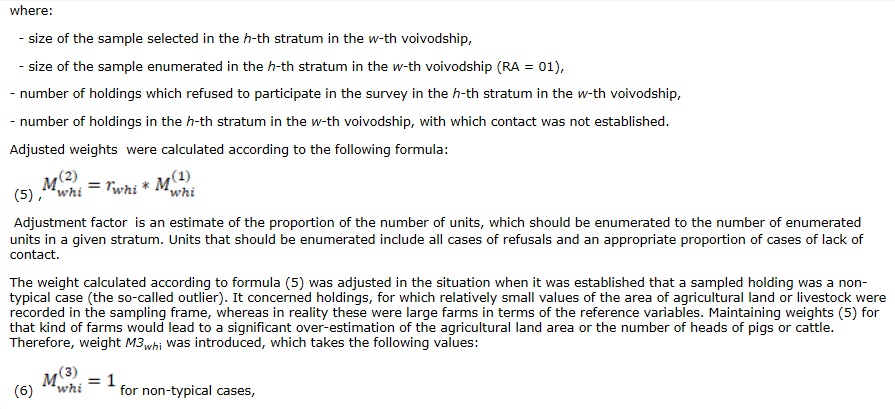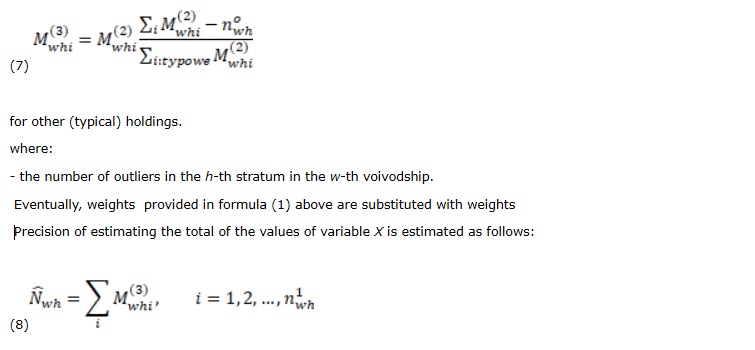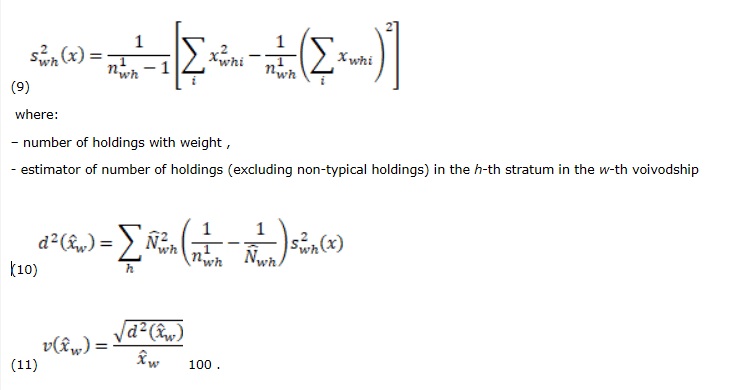 |
|
 |
|
| For any question on data and metadata, please contact: Eurostat user support |
|
|||
| 1.1. Contact organisation | Statistics Poland |
||
| 1.2. Contact organisation unit | Balances and Economic Accounts in Agriculture Unit |
||
| 1.5. Contact mail address | 00-925 Warszawa, Al. Niepodległości 208, Poland |
||
|
|||||||||||||||||||||||||||
| 2.1. Data description | |||||||||||||||||||||||||||
Main characteristics
|
|||||||||||||||||||||||||||
| 2.2. Classification system | |||||||||||||||||||||||||||
The classification system is described in the handbook. For each agricultural commodity the final crop balance sheet has in principle the same structure. Supply = Opening stock (1st January) + Usable Production + Imports Use = Domestic + Exports + Closing stock (31st December) Combined Nomenclature CN, Polish Classification of Activities (Polish abbreviation PKD), Polish Classification of Products and Services (Polish abbreviation PKWiU). For a balance sheet 'supply' equals 'use'. Related to terminology it should be mentioned that in publications sometimes for 'use' also 'demand' is used. 'Change in stocks' corresponds to the difference between closing stocks and opening stocks. |
|||||||||||||||||||||||||||
| 2.3. Coverage - sector | |||||||||||||||||||||||||||
Main cereals and oilseeds |
|||||||||||||||||||||||||||
| 2.4. Statistical concepts and definitions | |||||||||||||||||||||||||||
Statistical concepts and definitions are described in the Eurostat handbook. |
|||||||||||||||||||||||||||
| 2.5. Statistical unit | |||||||||||||||||||||||||||
The whole chain from farms to users (including traders, people in charge of stocks, a.s.o) |
|||||||||||||||||||||||||||
| 2.6. Statistical population | |||||||||||||||||||||||||||
Whole country - Poland. Balances are made for the country level, based on the results of a number of statistical surveys. |
|||||||||||||||||||||||||||
| 2.7. Reference area | |||||||||||||||||||||||||||
|
|||||||||||||||||||||||||||
| 2.8. Coverage - Time | |||||||||||||||||||||||||||
Calendar year 2019 and 2020 |
|||||||||||||||||||||||||||
| 2.9. Base period | |||||||||||||||||||||||||||
Not applicable |
|||||||||||||||||||||||||||
|
||||||||||||||||||||||||||||||||||||||||||||||||||||||||||||||||||||||||||||||||||||||||||||||||||||||||||||||||||||||||||||||||||||||||||||||||||||||||||||||||||||||
Data from primary surveys (crops, sown area, stocks at producers, traders and in agriculture as well as data on industrial production and processing, feed production) are not subject to processing. However, foreign trade data is processed by conversion into grain using conversion factors. |
||||||||||||||||||||||||||||||||||||||||||||||||||||||||||||||||||||||||||||||||||||||||||||||||||||||||||||||||||||||||||||||||||||||||||||||||||||||||||||||||||||||
| 3.1. Source data | ||||||||||||||||||||||||||||||||||||||||||||||||||||||||||||||||||||||||||||||||||||||||||||||||||||||||||||||||||||||||||||||||||||||||||||||||||||||||||||||||||||||
Data source details
Experts
|
||||||||||||||||||||||||||||||||||||||||||||||||||||||||||||||||||||||||||||||||||||||||||||||||||||||||||||||||||||||||||||||||||||||||||||||||||||||||||||||||||||||
| 3.2. Frequency of data collection | ||||||||||||||||||||||||||||||||||||||||||||||||||||||||||||||||||||||||||||||||||||||||||||||||||||||||||||||||||||||||||||||||||||||||||||||||||||||||||||||||||||||
Every year – according to the provisions in the Statistical Surveys Programme |
||||||||||||||||||||||||||||||||||||||||||||||||||||||||||||||||||||||||||||||||||||||||||||||||||||||||||||||||||||||||||||||||||||||||||||||||||||||||||||||||||||||
| 3.3. Data collection | ||||||||||||||||||||||||||||||||||||||||||||||||||||||||||||||||||||||||||||||||||||||||||||||||||||||||||||||||||||||||||||||||||||||||||||||||||||||||||||||||||||||
Census
|
||||||||||||||||||||||||||||||||||||||||||||||||||||||||||||||||||||||||||||||||||||||||||||||||||||||||||||||||||||||||||||||||||||||||||||||||||||||||||||||||||||||
| 3.4. Data validation | ||||||||||||||||||||||||||||||||||||||||||||||||||||||||||||||||||||||||||||||||||||||||||||||||||||||||||||||||||||||||||||||||||||||||||||||||||||||||||||||||||||||
|
||||||||||||||||||||||||||||||||||||||||||||||||||||||||||||||||||||||||||||||||||||||||||||||||||||||||||||||||||||||||||||||||||||||||||||||||||||||||||||||||||||||
| 3.5. Data compilation | ||||||||||||||||||||||||||||||||||||||||||||||||||||||||||||||||||||||||||||||||||||||||||||||||||||||||||||||||||||||||||||||||||||||||||||||||||||||||||||||||||||||
|
||||||||||||||||||||||||||||||||||||||||||||||||||||||||||||||||||||||||||||||||||||||||||||||||||||||||||||||||||||||||||||||||||||||||||||||||||||||||||||||||||||||
| 3.6. Adjustment | ||||||||||||||||||||||||||||||||||||||||||||||||||||||||||||||||||||||||||||||||||||||||||||||||||||||||||||||||||||||||||||||||||||||||||||||||||||||||||||||||||||||
Not applicable. |
||||||||||||||||||||||||||||||||||||||||||||||||||||||||||||||||||||||||||||||||||||||||||||||||||||||||||||||||||||||||||||||||||||||||||||||||||||||||||||||||||||||
|
||||||||||||||
To ensure the quality of processes and products, Statistics Poland applies the EFQM Excellence Model, the EU Statistical Practices Code and the ESS Quality Assurance Principles (QAF). Statistics Poland is also guided by the requirements provided for in § 7. "Principles and quality criteria for the creation of official statistics" of the Act on public statistics. |
||||||||||||||
| 4.1. Quality assurance | ||||||||||||||
|
||||||||||||||
| 4.2. Quality management - assessment | ||||||||||||||
Development since the last quality report
ext-container hidden">
|
||||||||||||||
|
||||||||||
- |
||||||||||
| 5.1. Relevance - User Needs | ||||||||||
|
||||||||||
| 5.2. Relevance - User Satisfaction | ||||||||||
|
||||||||||
| 5.3. Completeness | ||||||||||
|
||||||||||
|
||||||||||||||||||||||||||||||||||||||||||||||||||||||||||||||||||||||||||||||||||||||||||||||||||||||||
Not applicable. |
||||||||||||||||||||||||||||||||||||||||||||||||||||||||||||||||||||||||||||||||||||||||||||||||||||||||
| 6.1. Accuracy - overall | ||||||||||||||||||||||||||||||||||||||||||||||||||||||||||||||||||||||||||||||||||||||||||||||||||||||||
|
||||||||||||||||||||||||||||||||||||||||||||||||||||||||||||||||||||||||||||||||||||||||||||||||||||||||
| 6.2. Sampling error | ||||||||||||||||||||||||||||||||||||||||||||||||||||||||||||||||||||||||||||||||||||||||||||||||||||||||
|
||||||||||||||||||||||||||||||||||||||||||||||||||||||||||||||||||||||||||||||||||||||||||||||||||||||||
| 6.3. Non-sampling error | ||||||||||||||||||||||||||||||||||||||||||||||||||||||||||||||||||||||||||||||||||||||||||||||||||||||||
See sections below. |
||||||||||||||||||||||||||||||||||||||||||||||||||||||||||||||||||||||||||||||||||||||||||||||||||||||||
| 6.3.1. Coverage error | ||||||||||||||||||||||||||||||||||||||||||||||||||||||||||||||||||||||||||||||||||||||||||||||||||||||||
Census
|
||||||||||||||||||||||||||||||||||||||||||||||||||||||||||||||||||||||||||||||||||||||||||||||||||||||||
| 6.3.2. Measurement error | ||||||||||||||||||||||||||||||||||||||||||||||||||||||||||||||||||||||||||||||||||||||||||||||||||||||||
Census
|
||||||||||||||||||||||||||||||||||||||||||||||||||||||||||||||||||||||||||||||||||||||||||||||||||||||||
| 6.3.3. Non response error | ||||||||||||||||||||||||||||||||||||||||||||||||||||||||||||||||||||||||||||||||||||||||||||||||||||||||
Census
|
||||||||||||||||||||||||||||||||||||||||||||||||||||||||||||||||||||||||||||||||||||||||||||||||||||||||
| 6.3.4. Processing error | ||||||||||||||||||||||||||||||||||||||||||||||||||||||||||||||||||||||||||||||||||||||||||||||||||||||||
Census
|
||||||||||||||||||||||||||||||||||||||||||||||||||||||||||||||||||||||||||||||||||||||||||||||||||||||||
| 6.3.5. Model assumption error | ||||||||||||||||||||||||||||||||||||||||||||||||||||||||||||||||||||||||||||||||||||||||||||||||||||||||
Not applicable. |
||||||||||||||||||||||||||||||||||||||||||||||||||||||||||||||||||||||||||||||||||||||||||||||||||||||||
| 6.4. Seasonal adjustment | ||||||||||||||||||||||||||||||||||||||||||||||||||||||||||||||||||||||||||||||||||||||||||||||||||||||||
Not applicable. |
||||||||||||||||||||||||||||||||||||||||||||||||||||||||||||||||||||||||||||||||||||||||||||||||||||||||
| 6.5. Data revision - policy | ||||||||||||||||||||||||||||||||||||||||||||||||||||||||||||||||||||||||||||||||||||||||||||||||||||||||
Not applicable. |
||||||||||||||||||||||||||||||||||||||||||||||||||||||||||||||||||||||||||||||||||||||||||||||||||||||||
| 6.6. Data revision - practice | ||||||||||||||||||||||||||||||||||||||||||||||||||||||||||||||||||||||||||||||||||||||||||||||||||||||||
|
||||||||||||||||||||||||||||||||||||||||||||||||||||||||||||||||||||||||||||||||||||||||||||||||||||||||
|
||||||||
| 7.1. Timeliness | ||||||||
|
||||||||
| 7.2. Punctuality | ||||||||
|
||||||||
|
||||||||||
Not applicable. |
||||||||||
| 8.1. Comparability - geographical | ||||||||||
To be assessed by Eurostat |
||||||||||
| 8.1.1. Asymmetry for mirror flow statistics - coefficient | ||||||||||
Not applicable |
||||||||||
| 8.2. Comparability - over time | ||||||||||
|
||||||||||
| 8.3. Coherence - cross domain | ||||||||||
|
||||||||||
| 8.4. Coherence - sub annual and annual statistics | ||||||||||
Not applicable |
||||||||||
| 8.5. Coherence - National Accounts | ||||||||||
Not applicable |
||||||||||
| 8.6. Coherence - internal | ||||||||||
Not applicable |
||||||||||
|
||||||||||||
- |
||||||||||||
| 9.1. Dissemination format - News release | ||||||||||||
|
||||||||||||
| 9.2. Dissemination format - Publications | ||||||||||||
|
||||||||||||
| 9.3. Dissemination format - online database | ||||||||||||
|
||||||||||||
| 9.4. Dissemination format - microdata access | ||||||||||||
|
||||||||||||
| 9.5. Dissemination format - other | ||||||||||||
| 9.6. Documentation on methodology | ||||||||||||
|
||||||||||||
| 9.7. Quality management - documentation | ||||||||||||
|
||||||||||||
|
||||||||
|
||||||||
|
||||||
- |
||||||
| 11.1. Confidentiality - policy | ||||||
|
||||||
| 11.2. Confidentiality - data treatment | ||||||
|
||||||
|
|||
Completing such a Report is very complicated. Crop and oilseeds balances are made based on a number of primary statistical surveys, experts estimations as well as administrative data on export and import. To make a balance sheet it requires a lot of additional knowledge on general situation in agriculture both in the country and in the world. A lot of questions in this report relates to statistical surveys in general but not specifically to balances, which are “secondary” activity. In our opinion the quality report for such a task – balance calculations based on the results of sample surveys and other sources should be simplified and adjusted to the concrete undertaking. |
|||
|
|||
|
|||
| CropsBS-Annex |
|||





